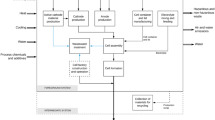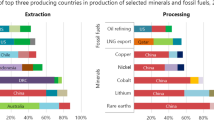Abstract
It seems clear that energy production is one of the key aspects of global sustainability. Economic, social and environmental aspects must be taken into account in order to design appropriate policies and thus, multicriteria analysis becomes a very adequate tool to deal with real problems of this kind. This study was directed by the Regional Ministry of Environment of Andalucía, who wanted to know the impact on the cost and on the environmental damage of a potential mix, more focused on renewable sources. Some authorities of the Ministry acted as decision maker in the interactive process. As a result, we have built a linear multiobjective model, in order to determine the optimal electrical mix for the Spanish region of Andalucía. Namely, we determine how much electricity power should be installed and produced, by each of the eight generation systems considered (lignite, other coals, oil, natural gas, nuclear, photovoltaic, wind and mini-hydro). Apart from the economic criterion (yearly cost), we have considered the vulnerability (in terms of percentage of imported fuel) as a strategic criterion, and 12 environmental criteria, which have been derived using the Life Cycle Analysis method on the different production systems. The interactive system PROMOIN was used to solve the multiobjective problem. PROMOIN allows the decision maker to choose how to give preference information to the system, and enables changing it anytime during the solution process, which gives more flexibility to the decision maker and increases the confidence of the decision maker in the final solution.








Similar content being viewed by others
Notes
The fuels used in co-generation plants are natural gas (85%), fuel oil/gas oil (10%) and others (5%).
References
Akimoto K, Fujii Y, Sekiguchi T, Yamaji K (1998) Decision analysis under uncertain CO2 regulation policies with a global energy model and its implication for power system planning. Int J Glob Energy Issues 11:33–41
Alanne K, Salo A, Saari A, Gustafsson SI (2007) Multi-criteria evaluation of residential energy supply systems. Energy Build 39:1218–1226
Antunes C, Martins A (2003a) Preface. Ann Oper Res 120:15–17
Antunes C, Martins A (2003b) Preface. Ann Oper Res 121:15–17
Belton V, Greco S, Eskelinen P, Molina J, Ruiz F, Slowinski R (2008) Interactive multiobjective optimization from a learning perspective. In: Branke J, Deb K, Miettinen K, Slowinski R (eds) Multiobjective optimization: interactive and evolutionary approaches. Springer, Heidelberg, pp 405–434
Benayoun R, de Montgolfier J, Tergny J, Laritchev O (1971) Programming with multiple objective functions: step method (STEM). Math Program 1:366–375
Buchanan JT (1997) A naïve approach for solving MCDM problems: the GUESS method. J Oper Res Soc 48:202–206
Caballero R, Luque M, Molina J, Ruiz F (2002) PROMOIN: an interactive system for multiobjective programming. Inf Technol Decis Mak 1:635–656
Chankong V, Haimes YY (1978) The interactive surrogate worth trade-off (ISWT) method for multiobjective decision making. In: Zionts S (ed) Multiple criteria problem solving. Springer, Berlin, pp 42–67
Climaco J, Antunes C, Martins A, Marta J, Almeida A (1990) A decision support system for power generation expansion planning with a case study. Proc IEEE Conf Decis Control 1:264–270
Diakoulaki D, Antunes C, Martins A (2005) MCDA and energy planning. In: Figueira J, Greco S, Ehrgot M (eds) Multiple criteria decision analysis. State of the art surveys. Springer, New York, pp 859–898
Dyer JS (1973) A time-sharing computer program for the solution of the multiple criteria problem. Manag Sci 19:1379–1383
European Commission (1995) An energy policy for the European Union: White Paper, COM(95) 682
Geoffrion AM, Dyer JS, Feinberg A (1972) An interactive approach for multi-criterion optimization, with an application to the operation of an academic department. Manag Sci 19:357–368
Han S, Kim B (2009) A study on the generation expansion planning system under the cost based pool. Trans Korean Inst Electr Eng 58:918–922
Hu Z, Tan X, Yang F, Yang M, Wen Q, Shan B, Han X (2010) Integrated resource strategic planning: case study of energy efficiency in the Chinese power sector. Energy Policy 38:6391–6397
Huang JP, Poh KL, Ang BW (1995) Decision analysis in energy and environmental modelling. Energy 20(9):843–855
IDAE (2000) Environmental impacts of the electricity generation. Life cycle analysis of eight electricity generation technologies (in Spanish). Ministry of Science and Technology of Spain
Jaber JO, Jaber QM, Sawalha SA, Mohsen MS (2008) Evaluation of conventional and renewable energy sources for space heating in the household sector. Renew Sustain Energy Rev 12:278–289
Kaleta M, Ogryczak W, Toczylowski E, Zoltowska I (2003) On multiple criteria decision support for suppliers on the competitive electric power market. Ann Oper Res 121:79–104
Kaliszewski I (2004) Out of the mist—towards decision-maker-friendly multiple criteria decision making support. Eur J Oper Res 158:293–307
Korhonen P, Laakso J (1986) A visual interactive method for solving the multiple criteria problem. Eur J Oper Res 24:277–287
Korhonen P, Syrjanen MJ (2003) Evaluation of cost efficiency in Finnish electricity distribution. Ann Oper Res 121:105–122
Korhonen P, Wallenius J (1988) A Pareto race. Nav Res Logist 35(6):615–623
Korhonen P, Wallenius J (1996) Behavioural issues in MCDM: neglected research questions. J Multi-Criteria Decis Anal 5:178–182
Koroneos C, Michailidis M, Moussiopoulos N (2004) Multi-objective optimization in energy systems: the case study of Lesvos Island, Greece. Renew Sustain Energy Rev 8:91–100
Linares P, Romero C (2000) A multiple criteria decision making approach for electricity planning in Spain: economic versus environmental objectives. J Oper Res Soc 51:736–743
Linares P, Romero C (2002) Aggregation of preferences in an environmental economics context: a goal-programming approach. Omega 30:89–95
Loken E (2007) Use of multicriteria decision analysis methods for energy planning problems. Renew Sustain Energy Rev 11:1584–1595
Luque M, Caballero R, Molina J, Ruiz F (2007) Equivalent information for multiobjective interactive procedures. Manag Sci 53:125–134
Luque M, Yang JB, Wong BYH (2009) PROJECT method for multiobjective optimization based on the gradient projection and reference points. IEEE Trans Syst Man Cybern, Part A, Syst Hum 39(4):864–879
Luque M, Ruiz F, Steuer R (2010) Modified interactive Chebyshev algorithm (MICA) for convex multiobjective programming. Eur J Oper Res 204(3):557–564
Luque M, Ruiz F, Miettinen K (2011) Global formulation for interactive multiobjective optimization. OR Spektrum 33(1):27–48
Miettinen KM (1999) Nonlinear multiobjective optimization. Kluwer, Boston
Miettinen K, Mäkelä MM (1995) Interactive bundle-based method for nondifferentiable multiobjective optimization: NIMBUS. Optimization 34:231–246
Miettinen K, Ruiz F, Wierzbicki AP (2008) Introduction to multiobjective optimization: interactive approaches. In: Branke J, Deb K, Miettinen K, Slowinski R (eds) Multiobjective optimization: interactive and evolutionary approaches. Springer, Heidelberg, pp 27–57
Miettinen K, Eskelinen P, Ruiz F, Luque M (2010) NAUTILUS method: an interactive technique in multiobjective optimization based on the nadir point. Eur J Oper Res 206(2):426–434
Munda G (2005) Multiple criteria decision analysis and sustainable development. In: Figueira J, Greco S, Ehrgot M (eds) Multiple criteria decision analysis. State of the art surveys. Springer, New York, pp 953–986
Nakayama H, Sawaragi Y (1984) Satisfying trade-off method for multiobjective programming. In: Grauer M, Wierzbicki AP (eds) Interactive decision analysis. Springer, Berlin, pp 113–122
Sakawa M (1982) Interactive multiobjective decision making by the sequential proxy optimization technique. Eur J Oper Res 9:386–396
Shayeghi H, Jalilzadeh S, Mahdavi M, Hadadian H (2008) Studying influence of two effective parameters on network losses in transmission expansion planning using DCGA. Energy Convers Manag 49:3017–3024
Steuer RE (1986) Multiple criteria optimization: theory, computation and application. Wiley, New York
Steuer RE, Choo EU (1983) An interactive weighted Tchebycheff procedure for multiple objective programming. Math Program 26:326–344
Tsoutsos T, Drandaki M, Frantzeskaki N, Iosifidis E, Kiosses I (2009) Sustainable energy planning by using multi-criteria analysis application in the island of Crete. Energy Policy. doi:10.1016/j.enpol.2008.12.011
Wierzbicki AP (1980) The use of reference objectives in multiobjective optimization. In: Fandel G, Gal T (eds) Lecture notes in economics and mathematical systems, vol 177. Springer, Berlin, pp 468–486
Zhou P, Ang BW, Poh KL (2006) Decision analysis in energy and environmental modeling: an update. Energy 31(14):2604–2622
Zionts S, Wallenius J (1983) An interactive multiple objective linear programming method for a class of underlying utility functions. Manag Sci 29:519–529
Acknowledgements
This research was partially supported by the Andalusian Regional Ministry of Environment, by the Andalusian Regional Ministry of Innovation, Science and Enterprises (PAI group SEJ-445 and P09-FQM-5001), and by the Ministry of Science and Innovation of Spain (Research Projects MTM2009-07646 and MTM2010-14992). The authors wish to express their gratitude to Prof. Carlos Romero, from the Technical University of Madrid, and to Dr. Pedro Linares, from the University Pontificia de Comillas (Madrid), for their very helpful comments and suggestions. Finally, the authors wish to thank the comments of two anonymous referees, who contributed to improve the quality of the paper.
Author information
Authors and Affiliations
Corresponding author
Rights and permissions
About this article
Cite this article
Cabello, J.M., Luque, M., Miguel, F. et al. A multiobjective interactive approach to determine the optimal electricity mix in Andalucía (Spain). TOP 22, 109–127 (2014). https://doi.org/10.1007/s11750-011-0236-2
Received:
Accepted:
Published:
Issue Date:
DOI: https://doi.org/10.1007/s11750-011-0236-2
Keywords
- Electricity supply
- Renewable energy
- Sustainable development
- Multiobjective programming
- Interactive methods




